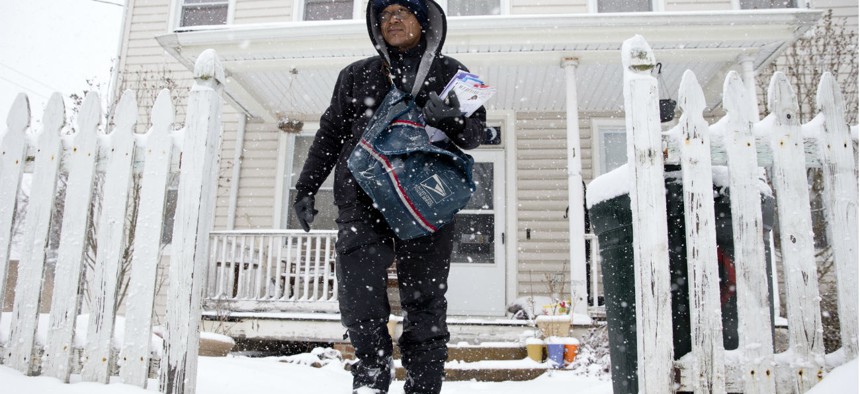
Carolyn Kaster/AP file photo
How Talking to the Elderly and Assessing Air Quality Could Help USPS Grow Revenue
The Postal Service is pursuing opportunities, but such efforts are more likely to benefit society writ large than the agency's finances.
The U.S. Postal Service could integrate services to benefit other federal agencies and society at large into its vast delivery network, according to a new report, but such offerings would do little to improve the mailing agency’s bleak financial outlook.
As last-mile delivery accounts for a growing percentage of USPS’ costs, the agency has begun to consider ways it can take advantage of its presence in every American community to grow revenue. The Postal Service will struggle to reduce costs on that part of its business, the Government Accountability Office found in its assessment, as it is statutorily obligated to deliver to every address six days per week. The last-mile portion of postal costs have grown by nearly 20% since 2008, while the rest of its operational costs have shrunk by 7%.
“USPS’ universal service obligation limits its ability to reduce last-mile delivery costs,” GAO said. “This obligation necessitates, among other things, a large, ongoing, number of mail carrier workhours and a large delivery vehicle fleet to provide 6-day delivery to an increasing number of delivery points.”
The auditors also noted, however, that the delivery network is “unique in its ubiquity,” creating some opportunities the agency can pursue. While previous efforts have examined how the Postal Service could take advantage of its retail network, such as offering banking services at post offices, GAO looked specifically at how the agency could further monetize its vehicle fleet and mobile workforce. USPS is, by law, limited in what non-postal services it can provide, but has made some efforts to engage with other federal agencies and private companies.
The Postal Service attempted a program in which mail carriers identified “unusual mail accumulation,” which could show signs of distress, particularly among the elderly. While the program was voluntary, collected no fees and saw limited participation, GAO suggested USPS could create a widespread effort to have carriers check in on older or homebound residents for a fee. The auditors noted such a program could have societal benefits such as reducing social isolation for those residents.
Its implementation, however, could come with significant costs. USPS would likely have to train its mail carriers for the interactions, and potential services such as trash removal, house maintenance or simply adding conversations to routes would make employees move more slowly. The French post has implemented a similar program, but has collected only about $200,000 in revenue from it annually.
The Postal Service could also leverage its employees to report signs of blight to local governments or the Housing and Urban Development Department, GAO said. HUD and the Federal Emergency Management Agency said such a program would be helpful in disaster recovery zones, while cities could use the information to preemptively target blight. Such programs would likely generate little revenue, however, with HUD noting it would be up to local governments to pay.
GAO noted both programs would distract mail carriers from their core delivery duties.
USPS could pursue other options that would not likely place any encumbrance on its mail carriers, such as putting devices on vehicles that assess the quality of air, roads and bridges, or cellular coverage. The Postal Service is planning to issue a request for proposals on such an effort. It has already launched a pilot program with a private company that placed sensors on USPS vehicles that assessed road and pavement quality. The pilot did not provide any revenue to the Postal Service but was successful and management told GAO it will pursue further opportunities.
The mailing agency has partnered with agencies like HUD, the Census Bureau and the Agriculture Department’s Animal and Plant Health Inspection Service to provide address information, but those efforts have brought in less than $50,000 in revenue. It has also provided address data to private companies, which provided $26.5 million in revenue to the Postal Service in fiscal 2018. GAO noted USPS is limited in what information it is allowed to provide, but could grow that revenue stream if some restrictions were lifted.
Ultimately, however, GAO found the Postal Service’s opportunities lie more with benefiting society than its own bottom line.
“While any net revenues generated from these non-postal services would benefit USPS, it is not likely that they would materially affect USPS’s financial condition, given the extent of USPS’s yearly operational losses,” GAO said.
While postal management is actively pursuing revenue streams like those explored by GAO, officials also appeared less than enthusiastic about the prospects presented in the report.
“According to USPS,” GAO wrote, “adding non-postal services to the current duties of mail carriers could negatively impact mail delivery services and jeopardize the ability of USPS to carry out its universal service obligation.”







